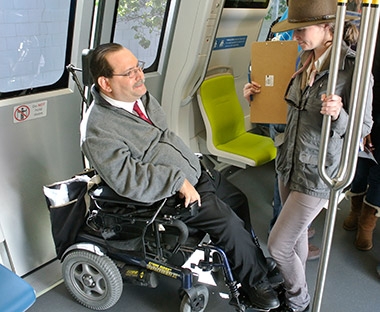DRC ensures public transportation is accessible to people with disabilities

DRC ensures public transportation is accessible to people with disabilities

DRC reaches largest settlement of its kind with BART
Ann Cupolo was dressed for an evening at the theater with her husband. When she rolled her wheelchair onto an elevator at a San Francisco BART station, she had to go through urine and feces. This was a common experience for people with disabilities. There were other problems with BART. BART often had broken elevators and escalators with no advanced notice for riders, leaving them stranded upon arrival at their destination stations. Riders could not enter turnstiles and had to wait for station agents to help them. At least one station lacked an accessible route from the parking lot. These issues violate the Americans with Disabilities Act. Ms. Cupolo and seven other riders contacted Protection and Advocacy (PAI), now Disability Rights California (DRC), and agreed to be lead plaintiffs in a class action lawsuit filed in July of 1996.
In 1998, PAI and Disability Rights Advocates reached the largest settlement of its kind on behalf of BART riders with disabilities. BART agreed to a number of corrective actions. They fixed and replaced station elevators and escalators and agreed to:
- Regularly maintain and clean the elevators.
- Let riders know when elevators and escalators were not working.
- Create accessible turnstiles.
- Make accessible paths from parking lots.
Case class members received five-year passes to ride free. The case affected about 40,000 riders with disabilities.
BART prototype cars not accessible
 In 2015, we received a number of complaints about the accessibility of the prototypes of the new fleet of BART cars. Attorney Fred Nisen, who uses a wheelchair, tested one out and found it was not accessible because a pole blocked the middle doors. Fred met with individual members of the BART Board of Directors at the prototype demonstration and they told him the pole protected some people from falling, especially those with disabilities. However, it created barriers for people who used wheelchairs and blind people with canes who walked into the poles.
In 2015, we received a number of complaints about the accessibility of the prototypes of the new fleet of BART cars. Attorney Fred Nisen, who uses a wheelchair, tested one out and found it was not accessible because a pole blocked the middle doors. Fred met with individual members of the BART Board of Directors at the prototype demonstration and they told him the pole protected some people from falling, especially those with disabilities. However, it created barriers for people who used wheelchairs and blind people with canes who walked into the poles.
“I wrote a letter to the board that was read at a meeting,” Fred said. “I also spoke with the Oakland Mayor’s Commission on Persons with Disabilities and BART’s Accessibility Task Force about the issue.” He said Independent Living Resource Center SF retained Disability Rights Advocates (DRA) about the issues and DRA sent BART a demand letter. It quickly agreed to negotiate. Fred provided DRA with technical assistance in the negotiations. BART finally agreed to remove the poles from the middle doors of the trains. It also added space for two wheelchairs.




